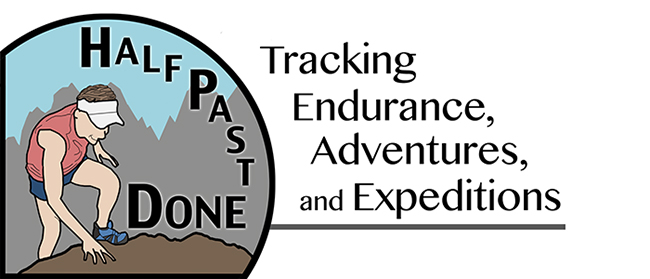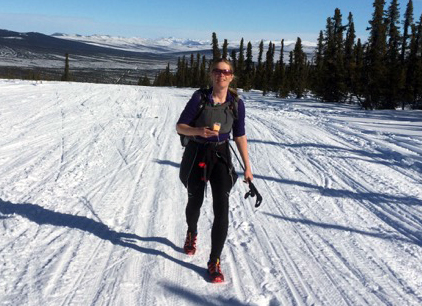Six days before the White Mountains 100 — a 100-mile winter ultramarathon held in Fairbanks, Alaska in late March — I received an official invite to the race, ending several months of wait-list limbo and unfocused training. I also had access to none of the running-specific gear I’d sent away in anticipation of this potential invite. Our Alaska travel plans had just changed, and my gear was stuck in the U.S. Postal Service’s system, somewhere between Fairbanks and Nome (I hoped.) Either way, the box was missing, and I was left without shoes to wear for a hundred miles of running through soft snow and ice in temperatures ranging from 5 below zero to 45 above.
When it comes to running shoes, I gravitate toward maximum cushioning. As “maximalist” shoes gained popularity in the past few years, runners would frequently approach me at the start of trail races to ask questions about my shoes, observing, “So you’re one of those Hoka converts.” I’d joke that I was “born into” Hokas rather than a convert, since I only started running regularly in 2010, and the Hoka One One Mafate 1 was the first pair of runnings shoes I owned. I’m also an avid mountain biker, and believe suspension to be a key feature on long rides through rugged terrain. Full suspension saves a lot of wear and tear on the body from having to absorb the full impact of every rock and bump. It just made sense that the same logic applies to running and shoes.
Winter running, however, has a different set of needs that out-rank maximum comfort. High on this list of needs are waterproof outers, to keep melted snow from seeping into the mesh and soaking feet, which can quickly lead to frostbite. Hoka’s selection of waterproof shoes is limited, so for the past several years I’ve used Montrail Mountain Masochist GTX. These shoes were getting on in years, and also aren’t manufactured anymore. Even if my Montrails weren’t stuck in the USPS netherlands, I was soon going to be in the market for a new pair of winter running shoes.

The Spikecross 3s have a “Climasheild” membrane that stretches over the front portion of the tongue, making these shoes fully waterproof below the ankle. This feature was put to the test during the race while traversing a section of overflow — ice covering shallow, open water — called the Ice Lakes. I broke through the surface ice a few times, plunging into ankle-deep water, but my feet stayed dry. With a stiff breeze in the canyon and temperatures already nearing zero degrees, this feature was greatly appreciated.
The rubber outsole was impressively grippy, with large lugs that dug into the snow and provided ample traction even when mid-day warmth led to slippery, slushy trails. Sometimes, while climbing a steep hill, I’d reach out to grab an alder branch to prevent slipping backward, only to realize I didn’t have to because my feet were sticking to the trail just fine. The fantastic grip of these shoes has me thinking about a pair of Speedcross 3s for summer running on slippery, muddy trails. The Climasheild outers combined with ContraGrip outsole seem like a great solution for steep mountain runs in wet and cool conditions, when wet feet are inevitable and secure footing is key. There’s also a plastic mudguard around the perimeter of the shoe to protect feet from bashing on rocks.
The one feature that differentiates the Spikecross from the Speedcross is nine carbide studs in each shoe. Although I wouldn’t want to use studded shoes on wet rocks or long road runs, they make all the difference on ice. Knowing that Alaska’s White Mountains are prone to icy overflow, I was specifically looking for carbide-studded shoes. I wanted secure footing, but worried that the studs would disrupt my footing on non-icy surfaces. However, these studs maintain a low profile, and were unnoticeable while digging into packed snow, while still providing solid traction on even sloped and wet ice. I’d consider the Spikecross the go-to shoes for most winter trail conditions, including intermittently muddy and icy trails.
As for running a hundred miles in brand new, untested shoes, I managed to find a winner in this category as well. The shoe has a slightly narrow fit with a wide toe box, which worked great for the shape of my feet, as well as my need to give my toes some wiggle room at all times. I purchased these shoes a size and a half too large to accommodate for extra socks.
With most runners’ spring training in full swing, this blog post comes too late to provide a useful review of winter shoes. Still, wearing these Salomons for a hundred miles straight did open my eyes to the importance of functionality — not just comfort — in shoes. Before the White Mountains 100, I’d been so locked into Hokas that I couldn’t imagine running a non-winter ultra without mattresses on my feet, and shuddered at the thought of even six-mile training runs without them. Now, the Salomons have me thinking about the Speedcross to improve my chances of not falling on my face during muddy mountain runs, and may be the way to go if the weather is bad (which is almost inevitable) during the Ultra Trail du Mont Blanc in August, my next planned 100-miler. (Considering, but not yet convinced.)
Still, it’s an important lesson — sometimes the trails call for cushy full suspension, and sometimes you need to pull out the motocross tires.

